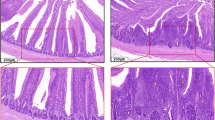Abstract
The present investigations were conducted to test the effects of T-2 toxin on electrophysiological variables of jejunal epithelium of chicken. Jejunal segments of broilers were monitored in Ussing chambers in the presence of T-2 toxin at the levels of 0 (negative control), 0 (methanol/vehicle control), 0.1, 1, 5, and 10 μg/ml of buffer. T-2 toxin did not affect basal values of short circuit current (Isc), transmural potential difference, or tissue conductivity in the jejunal epithelium. T-2 toxin also did not statistically affect glucose-induced electrophysiological variables during the first 3 min of glucose induction. Compared to the vehicle control, the ouabain-sensitive Isc was negatively affected (P = 0.008) only under 5 μg of T-2 toxin/ml. Increasing levels of T-2 toxin negatively affected the ouabain-sensitive Isc in a cubic (P = 0.007) fashion. These data indicate that acute exposure to moderate levels of T-2 toxin may progressively impair the cation gradient across the jejunal epithelium.
Similar content being viewed by others
References
Awad WA, Böhm J, Razzazi-Fazeli E, Zentek J (2005) In vitro effects of deoxynivalenol on electrical properties of intestinal mucosa of laying hens. Poult Sci 84:921–927
Awad WA, Razzazi-Fazeli E, Böhm J, Zentek J (2008) Effects of B-trichothecenes on luminal glucose transport across the isolated jejunal epithelium of broiler chickens. J Anim Physiol Anim Nutr 92:225–230. doi:10.1111/j.1439-0396.2007.00709.x
Bony S, Olivier-Loiseau L, Carcelen M, Devaux A (2007) Genotoxic potential associated with low levels of the Fusarium mycotoxins nivalenol and fusarenon X in a human intestinal cell line. Toxicol Vitro 21:457–465. doi:10.1016/j.tiv.2006.10.014
Fernandez YJ, Boigegrain RAM, Cambon-Gros CD, Mitjavila SE (1984) Sensitivity of Na+-coupled D-glucose uptake Mg2+-ATPase and sucrase to perturbations of the fluidity of brush-border membrane vesicles induced by n-aliphatic alcohols. Biochim Biophys Acta Biomembr 770:171–177. doi:10.1016/0005-2736(84)90127-5
Goto Y, Kida K, Kaino Y, Ito T, Matsuda H (1993) Inhibitory effect of amiloride on glucose transport in isolated rat adipocytes. Diabetes Res Clin Pract 20:1–5. doi:10.1016/0168-8227(93)90015-W
Hunder G, Schümann K, Strugala G, Gropp J, Fichtl B, Forth W (1991) Influence of subchronic exposure to low dietary deoxynivalenol, a trichothecene mycotoxin, on intestinal absorption of nutrients in mice. Food Chem Toxicol 29:809–814. doi:10.1016/0278-6915(91)90107.I
Kumagai S, Shimizu T (1988) Effects of Fusarenon-X and T-2 toxin on intestinal absorption of monosaccharide in rats. Arch Toxicol 61:489–495. doi:10.1016/0278-6915(91)90107-I
Maresca M, Mahfoud R, Garmy N, Fantini J (2002) The mycotoxin deoxynivalenol affects nutrient absorption in human intestinal epithelial cells. J Nutr 132:2723–2731
Sadakata T, Hatano H, Koseki T, Koganezawa M, Shimada I (2002) The effects of amiloride on the labellar taste receptor cells of the fleshfly Boettcherisca peregrina. J Insect Physiol 48:565–570. doi:20.1016/S0022-1910(02)00074-4
Suneja SK, Ram GC, Wagle DS (1984) Effects of T-2 toxin on glucose and tryptophan uptake and intestinal mucosal enzymes. Toxicon 22:39–43. doi:10.1016/0041-0101(84)90136-3
Yang G, Jarvis BB, Chung Y, Pestka JJ (2000) Apoptosis induction by the satratoxins and other trichothecene mycotoxins: relationship to ERK, p38 MAPK and SAPK/JNK activation. Toxicol Appl Pharmacol 164:149–160. doi:10.1006/taap.1999.8888
\Yunus AW, Awad WA, Kröger S, Zentek J, Böhm J (2010a) The dilemma of using aliphatic alcohols as solvent: effects on electrophysiological variables of chicken’s jejunal epithelium. Proc. 32nd Mycotoxin Workshop, Technical University of Denmark, Lyngby, p 151. (Abstr)
Yunus AW, Awad WA, Zentek J, Böhm J (2010b) In vitro aflatoxin B1 exposure decreases response to carbamylcholine in the jejunal epithelium of broilers. Poult Sci 89:1372–1378. doi:10.3382/ps.2009-00617
Yunus AW, Awad WA, Kröger S, Zentek J, Böhm J (2011) Dose dependent increase and decrease in active glucose uptake in jejunal epithelium of broilers after acute exposure to ethanol. Alcohol 45:411–414. doi:10.1016/j.alcohol.2010.08.005
Acknowledgments
The authors greatly acknowledge the technical assistance by Anett Kriesten and Wageha Ali Awad during the course of the experiments at the Institute of Animal Nutrition, Freie Universität Berlin.
Conflict of interest
None
Author information
Authors and Affiliations
Corresponding author
Rights and permissions
About this article
Cite this article
Yunus, A.W., Kröger, S., Tichy, A. et al. Electrophysiological response of chicken’s jejunal epithelium to increasing levels of T-2 toxin. Mycotoxin Res 29, 23–27 (2013). https://doi.org/10.1007/s12550-012-0142-y
Received:
Revised:
Accepted:
Published:
Issue Date:
DOI: https://doi.org/10.1007/s12550-012-0142-y




